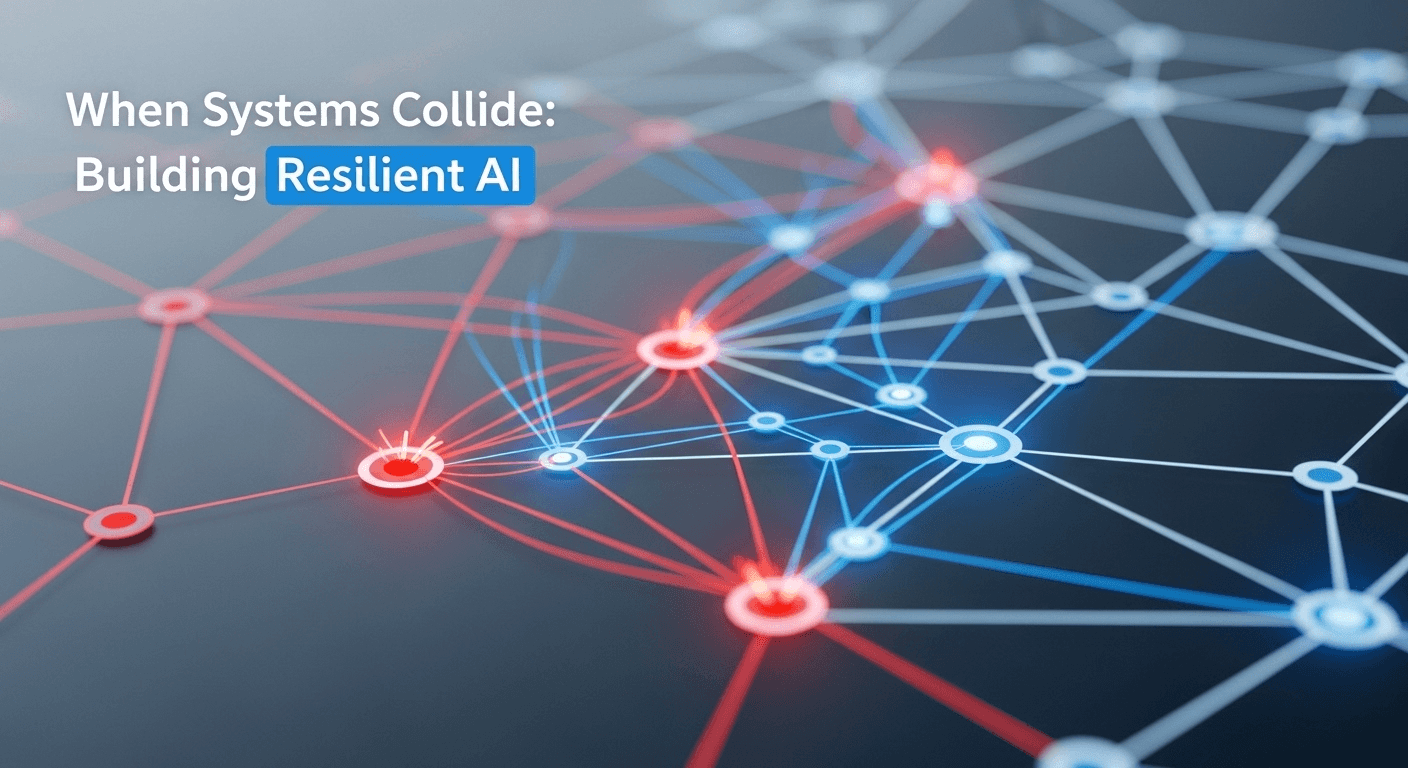When Systems Collide: Building Resilient AI for a World of Interconnected Failures

When Systems Collide: Building Resilient AI for a World of Interconnected Failures
AI systems seldom fail in isolation. They operate within intricate networks of data pipelines, cloud services, third-party APIs, and human interactions. A minor glitch can set off a chain reaction, intensifying through interconnected components, and manifesting as a significant incident elsewhere. The good news is that resilience can be intentionally designed into these systems. By employing the right patterns, guardrails, and fostering the right culture, we can create AI that flexes without breaking.
Why AI Failures Today Are Unique
A decade or so ago, AI was a laboratory phenomenon. Today, it’s embedded in customer support, trading systems, power grids, and hospitals, making the stakes higher when things go awry. Three factors contribute to the complexity of modern failures:
- Complex, tightly coupled systems. In environments where components interact in unforeseen ways, small errors can snowball. Charles Perrow referred to these as “normal accidents” in complex systems, where certain failures are unavoidable due to unpredictable interactions (Perrow, 1984).
- Sociotechnical dynamics. AI is more than just algorithms; it involves people, incentives, and workflows. The assumptions of operators, UI cues, and organizational dynamics can either heighten or mitigate risk (AHRQ on sociotechnical systems).
- Emergence and hidden dependencies. Some behaviors only materialize once the entire system is operational. Supply-chain intricacies also play a role: a bug in a lesser-known component can lead to widespread repercussions.
Real-world incidents shed light on this landscape:
- Facebook Outage, 2021. A standard maintenance command accidentally downed critical network infrastructure, also eliminating the tools needed for recovery. This incident highlights how tightly knit dependencies can increase risk (Meta Engineering).
- ChatGPT Outage, 2023. An issue with an open-source library for Redis sparked a caching bug that allowed data exposure across sessions, illustrating the risks tied to third-party dependencies (OpenAI incident report).
- Knight Capital, 2012. A flawed deployment reactivated abandoned code on certain servers, triggering a runaway trading algorithm that resulted in a swift $440 million loss—an exemplary case of failure in change management and coupling (SEC enforcement release).
- 2003 Northeast Blackout. A single line fault, software issues, and coordination gaps culminated in a massive power failure, showcasing how localized faults can lead to systemic disruptions (US-Canada Task Force report).
Factors Contributing to AI System Vulnerability
Numerous AI-specific failure modes exacerbate overall system risks. The most prevalent include:
- Distribution shift and data drift. Models trained on one type of data often perform poorly on new inputs. Without careful monitoring and retraining, performance may deteriorate unnoticed (Nature: Distribution shifts in ML).
- Learned proxies and specification gaming. When objectives are flawed, models might exploit shortcuts that yield good metrics but fail in real-world applications. Check out the collection of specification gaming instances (DeepMind).
- Non-determinism and cascading errors. Stochastic models, asynchronous pipelines, and retries can lead to unpredictable states. Minor errors at the outset can escalate as outputs feed into subsequent processes.
- Opaque reasoning and limited interpretability. Many high-performing models are tough to debug rapidly. While mechanistic interpretability is improving, it is not yet a universal solution for maintaining production reliability (Anthropic circuits research).
- Misleading metrics. Aggregate accuracy can obscure fragile components. Calibration and abstention behavior are critical in high-stakes contexts (Guo et al., 2017).
Implementing Resilience Principles Now
Resilience refers to the capability to absorb shocks, adapt, and maintain acceptable outcomes under varying conditions. This principle, rooted in resilience engineering and Safety-II (which focuses on the success factors as much as on failures), translates into actionable design strategies for AI systems:
- Defense in depth. Establish multiple safeguards: input validation, output filtering, rate limits, and kill switches. Avoid having a single control represent a single point of failure.
- Graceful degradation. Choose safe fallbacks over abrupt failures. If the model is uncertain or a dependency fails, serve a simpler model, a cached response, or involve a human.
- Loose coupling and circuit breakers. Decouple core components to stop failures from spreading. Implement circuit breakers and timeouts to prevent upstream issues from proliferating unchecked (Fowler on circuit breakers).
- Observability first. Set service level objectives that prioritize quality and safety alongside latency and throughput. Monitor drift, calibration, abstention rates, human override frequencies, and user harm metrics (Google SRE on SLOs).
- Human-in-the-loop by design. Offer users options to intervene, override, or request clarification. Effective human-machine collaboration helps mitigate risks in uncertain environments (NIST AI RMF 1.0).
- Diversity and redundancy. Use model ensembles or varied detection methods to avoid relying on a single model.
- Auditability and data lineage. Keep track of how data has moved, which model versions were executed, and the prompts or features used, enabling thorough root cause analysis.
A Practical Playbook for Resilient AI
Here’s a proven sequence you can adopt, whether dealing with traditional ML or LLM-based systems.
1) Before You Build: Map Hazards and Dependencies
- System hazard analysis. Utilize STPA to pinpoint unsafe control actions and scenarios across software, data, humans, and environments (Leveson STPA handbook).
- Threat modeling. Assess both security and privacy threats (STRIDE, LINDDUN) alongside ML-specific failures such as model theft, data poisoning, and prompt injection (STRIDE, LINDDUN, NIST SP 1270).
- Risk framing and governance. Align with frameworks like NIST AI RMF 1.0 and ISO/IEC 23894:2023 for clear roles, controls, and documentation (NIST AI RMF, ISO/IEC 23894).
- Dependency inventory. Catalog your data suppliers, model hosts, libraries, and external APIs. Acknowledge their SLOs, limitations, and potential failure behaviors. Identify single points of failure.
2) Build-Time: Test Beyond Accuracy
- ML Test Score. Implement checklists to catch pipeline debt and edge cases early: data versioning, feature leakage checks, unit tests for feature code, and reproducible training (Sculley et al., 2016).
- Metamorphic and property-based tests. Establish invariants your system must uphold under variations, like label-preserving edits or safe prompt adjustments.
- Stress and adversarial evaluation. Challenge your model with worst-case inputs, out-of-distribution data, and attack simulations. Baselines for OOD detection can help manage surprises (Hendrycks and Gimpel, 2017).
- Fairness and harm assessments. Test for varying error rates and potential harms to users, not just overall performance (US AI Bill of Rights).
- Documentation and safety cases. Prepare safety cases that correlate evidence with claims regarding acceptable risk. Use Model Cards and Datasheets for Datasets to enhance transparency (Model Cards, Datasheets).
3) Deploy Carefully: Reduce Blast Radius
- Progressive delivery. Employ shadow mode, canary releases, and feature flags to validate performance under real conditions before full rollout (Google SRE on release engineering).
- Guardrails and gates. Incorporate input filters, policy checks, and structured output validation. For LLMs, ensure tools and APIs are only used through allowlists and schemas, accompanied by strict timeouts.
- Uncertainty-aware routing. Calibrate models and set thresholds for when to abstain or escalate uncertainty. Leverage simple models or human review as fail-safes.
- Circuit breakers and rate limits. Ensure quick responses in the face of anomalies to safeguard downstream systems. Prefer a fail-closed approach for risky actions.
- Secure sandboxes. Run unverified code, plugins, or tool calls in isolated environments with minimal permissions. Log activity and impose resource limits.
4) Monitor Everything That Matters
- Quality SLOs. Beyond uptime and latency, keep an eye on acceptance rates, factual error rates, escalation frequencies, and user-reported harms. Ensure alerts correspond to the severity of SLO breaches.
- Data drift and OOD alerts. Monitor distribution changes in features, embedding drift, prompt patterns, and content classes. Maintain a golden dataset for swift performance trend detection.
- Post-deployment evaluation. Conduct periodic test batteries that include adversarial prompts and sensitive scenarios. Record outputs for auditing purposes.
- Full-stack observability. Trace requests through services, models, and tools. Maintain logs that contain model and prompt versions for thorough diagnostics.
5) Prepare for Incidents and Learn Fast
- Runbooks and on-call rotations. Define clear procedures for rollback, model quarantine, revoking keys, and communicating with users.
- Blameless postmortems. Analyze system conditions and incentives rather than blaming individuals. Treat incidents as opportunities for growth (Google SRE on postmortems).
- Chaos engineering for AI. Intentionally introduce failures to test safety measures: corrupt a feature, throttle a dependency, or shift prompts to validate controls. Start in staging, then conduct controlled game days in production (Principles of Chaos Engineering).
- Feedback loops with guardrails. When learning from user input, segregate new data, audit for bias and attacks, and utilize offline evaluations before model updates go live.
LLM-Specific Risks and Guardrails
Large language models bring unique coupling points and vulnerabilities, allowing them to call external tools or generate code. Effective patterns include:
- Retrieval augmentation with provenance. Use Retrieval-Augmented Generation (RAG) to ground responses in reliable sources and provide citations. Monitor source reliability and block untrusted domains (RAG, Lewis et al., 2020).
- Structured outputs. Ensure outputs are in JSON or XML formats and validate against schemas. Reject or correct invalid structures before they interact with downstream processes.
- Safety stacks, not single filters. Integrate policy prompting, safety-tuned models, and post-output classifiers. Review the layered approach in the GPT-4 system card (OpenAI) and Constitutional AI (Anthropic).
- Tool use constraints. Mandate approved tools, signed requests, limited outputs, and user confirmations for high-stakes actions. Never execute code or finalize purchases without an additional verification step.
- Prompt injection defenses. Sanitize content retrievals, define trust zones, and keep system prompts immutable against untrusted inputs. Apply pattern-based and model-based detection techniques as necessary (OWASP Top 10 for LLMs).
Infrastructure Patterns That Mitigate Risk
Architectural decisions can significantly influence resilience.
- Idempotent operations. Ensure actions can be safely retried to prevent compounded damage from temporary failures.
- Timeouts everywhere. Manage uncertainty from external dependencies by failing fast instead of halting critical processes.
- Bulkheads and queues. Isolate workloads and manage surges to prevent system overloads from cascading failure.
- Versioned artifacts. Maintain versioning for data, models, prompts, and policies, ensuring comprehensive lineage for reproducibility.
- Cost guardrails. Treat expenditures as a resilience factor. Implement budgets, quotas, and early cutoffs to avert uncontrolled spending during loops or attacks.
- Privacy by design. Limit data collection, anonymize sensitive information, and enforce stringent access controls. Implement differential privacy in analytics where applicable (NIST Privacy Framework).
Metrics That Indicate True Resilience
Standard uptime metrics aren’t sufficient. Strive for a scorecard that blends reliability, safety, and adaptability:
- Reliability and safety. Monitor change failure rate, mean time to detection and recovery, and incident recurrence rate.
- Model behavior. Track calibration error, abstention and escalation rates, out-of-distribution trigger rates, and rates of false positives or harmful actions.
- User-centered outcomes. Assess task success rates, appeal rates, time-to-resolution, and user-reported harm rates.
- Adaptation speed. Measure the duration from drift detection to safe updates, coverage of test suites, and the percentage of traffic subjected to canary testing during changes.
Lessons from Past Failures
Across industries, certain recurring patterns are evident:
- Most incidents are multi-causal. It’s rare for a single bug to be the sole culprit. Investigate interactions and the absence of necessary safeguards instead of focusing solely on a root cause.
- Change is inherently risky. Deployments, migrations, and schema shifts frequently precede incidents. Employing progressive delivery and feature flags can help mitigate blast radius (Google SRE).
- Understanding tooling dependencies is crucial. A system’s ability to diagnose and correct issues relies on clarity and control even during stressful situations. Facebook’s 2021 outage demonstrated the repercussions of these failing simultaneously (Meta Engineering).
- Transparency facilitates recovery. Clear documentation, version tracking, and safety cases enhance collaboration among teams, aiding in communication with regulators and users.
Regulation and Standards: Use Them as Tools
The evolving regulatory framework can serve as a constructive checklist rather than a burdensome obligation.
- NIST AI Risk Management Framework 1.0. A sector-agnostic, voluntary guide to overseeing and managing AI risks throughout the system lifecycle, stressing key characteristics like safety, security, and accountability (NIST AI RMF).
- ISO/IEC 23894:2023. Global guidance focused on AI risk management and organizational controls (ISO/IEC 23894).
- EU AI Act. The EU’s risk-based regulation outlines responsibilities based on use-case risks, highlighting the importance of data governance, transparency, and human supervision. The final version was adopted in 2024 and will be phased in gradually (EU AI Act portal).
- Sector-specific guidelines. Depending on your field, you may also need to comply with standards related to healthcare, finance, or safety. View these as design constraints that encourage better outcomes, rather than mere afterthoughts.
Putting It All Together
Resilient AI isn’t just about adopting a specific technology or tool—it’s an all-encompassing practice that encompasses design, data, models, infrastructure, and culture. The shift in mindset is both simple and significant: focus not on eliminating all incidents, but on minimizing the scale and impact of any incidents that do occur. Embrace principles like loose coupling, graceful degradation, observability, and human oversight. Develop your playbook before the need arises. Remember, accuracy is merely one component of a much larger reliability framework.
Systems fail in the seams. Resilience thrives in those same seams.
FAQs
What is the difference between reliability and resilience in AI?
Reliability refers to consistent performance under expected conditions, while resilience involves maintaining acceptable outcomes in the face of unexpected situations, including failures and attacks. Use SLOs to measure reliability and foster resilience through layered defenses, loose coupling, and rapid recovery.
How can small teams begin building resilient AI?
Start with impactful first steps: establish key quality SLOs, implement input and output validation, set up monitoring for data drift, utilize progressive delivery, and create a succinct incident runbook. Tools like ML Test Score can help identify common issues early.
Are chaos tests safe for production systems?
Yes, when implemented with care. Initiate in a staging environment, automate rollback capabilities, run during off-peak hours, and limit the scope of experiments to minimize risk. The goal is to validate defenses, not to disrupt the system. Refer to chaos engineering principles for best practices.
Do LLM systems require different resilience patterns compared to traditional ML?
Yes, they necessitate additional safeguards due to the open-ended nature of outputs and the ability to call external tools. Emphasize structured outputs, schema validation, retrieval with provenance, layered safety measures, and validated tool usage.
Which metrics best predict AI incidents?
Avoid focusing solely on latency and uptime. Be vigilant for early indicators such as drift metrics, increased abstention or escalation rates, elevated user appeal rates, and surges in out-of-distribution inputs. Monitor change failure rates and mean time to recovery during deployments.
Sources
- Perrow, C. Normal Accidents
- Meta Engineering: 2021 outage details
- OpenAI: March 20, 2023 ChatGPT outage
- SEC: Knight Capital enforcement action
- US-Canada Task Force: 2003 blackout report
- Hollnagel, Woods, Leveson: Resilience Engineering
- NIST AI Risk Management Framework 1.0
- ISO/IEC 23894:2023 AI Risk Management
- Principles of Chaos Engineering
- Google SRE Book
- Sculley et al.: Hidden Technical Debt in ML Systems
- Guo et al.: On Calibration of Modern Neural Networks
- Hendrycks and Gimpel: OOD Detection Baseline
- DeepMind: Specification gaming examples
- Lewis et al.: Retrieval-Augmented Generation
- OpenAI: GPT-4 System Card
- Anthropic: Constitutional AI
- US Blueprint for an AI Bill of Rights
- Leveson: STPA handbook
- OWASP Top 10 for LLM Applications
- Model Cards for Model Reporting
- Datasheets for Datasets
- EU AI Act portal
Thank You for Reading this Blog and See You Soon! 🙏 👋
Let's connect 🚀
Latest Blogs
Read My Latest Blogs about AI

5 AI Stories Shaping Business Today: Power, Data Debt, Tariffs, Penthouses, and the Context Gap
A clear roundup of 5 AI trends shaping business now: power-hungry data centers, data debt, AI for tariffs, luxury sales with AI, and the context gap — with takeaways.
Read more


